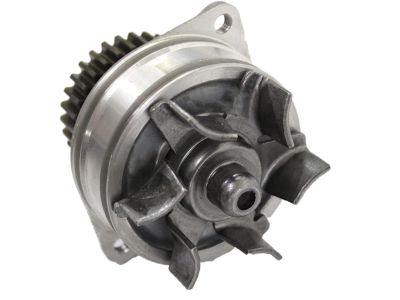×
- Live Chat
- 1-888-726-6993

My Garage
My Account
Cart
Genuine Nissan Pathfinder Water Pump
H2O Pump- Select Vehicle by Model
- Select Vehicle by VIN
Select Vehicle by Model
orMake
Model
Year
Select Vehicle by VIN
For the most accurate results, select vehicle by your VIN (Vehicle Identification Number).
21 Water Pumps found
Nissan Pathfinder Pump Assy-Water
Part Number: 21010-7S000$139.34 MSRP: $211.97You Save: $72.63 (35%)Ships in 1-3 Business DaysNissan Pathfinder Pump Assembly Water
Part Number: 21010-7Y026$135.69 MSRP: $196.32You Save: $60.63 (31%)Nissan Pathfinder Pump Assy-Water
Part Number: 21010-JA10A$122.61 MSRP: $186.50You Save: $63.89 (35%)Ships in 1-3 Business DaysNissan Pathfinder Pump Assembly Water
Part Number: 21010-3TA0B$92.23 MSRP: $140.28You Save: $48.05 (35%)Ships in 1-3 Business DaysNissan Pathfinder Pump Assy-Water
Part Number: 21010-7Y025$135.69 MSRP: $196.32You Save: $60.63 (31%)Nissan Pathfinder Pump Assembly Water
Part Number: 21010-6KA1A$158.26 MSRP: $240.73You Save: $82.47 (35%)Ships in 1-3 Business DaysNissan Pathfinder Pump Ass Wat
Part Number: 21010-12G26$92.54 MSRP: $140.77You Save: $48.23 (35%)Ships in 1-3 Business DaysNissan Pathfinder Pump Water
Part Number: 21010-0W027$162.07 MSRP: $223.23You Save: $61.16 (28%)Ships in 1-3 Business DaysNissan Pathfinder Pump Assy-Water
Part Number: 21010-31U28$89.53 MSRP: $136.18You Save: $46.65 (35%)Ships in 1-3 Business DaysNissan Pathfinder Motor Assy-Sub,Cooling
Part Number: 21580-3JV0A$488.25 MSRP: $672.52You Save: $184.27 (28%)Ships in 1-3 Business DaysNissan Pathfinder Pump Assy-Water
Part Number: 21010-31U85$89.53 MSRP: $136.18You Save: $46.65 (35%)Ships in 1-3 Business DaysNissan Pathfinder Pump Assy-Water
Part Number: 21010-6KA0A$158.26 MSRP: $240.73You Save: $82.47 (35%)Ships in 1-3 Business DaysNissan Pathfinder Pump Water
Part Number: 21010-0W028$162.07 MSRP: $223.23Limited AvailabilityYou Save: $61.16 (28%)Nissan Pathfinder Pump Assy-Water
Part Number: 21010-31U29$89.53 MSRP: $136.18You Save: $46.65 (35%)Ships in 1-3 Business DaysNissan Pathfinder Water Pump
Part Number: 21010-80W25$205.22 MSRP: $282.67You Save: $77.45 (28%)Ships in 1-3 Business DaysNissan Pathfinder Water Pump
Part Number: 21010-80W26$205.22 MSRP: $282.67Limited AvailabilityYou Save: $77.45 (28%)
| Page 1 of 2 |Next >
1-20 of 21 Results
Nissan Pathfinder Water Pump
If you need any OEM Nissan Pathfinder Water Pump, feel free to choose them out of our huge selection of genuine Nissan Pathfinder Water Pump. All our parts are offered at unbeatable prices and are supported by the manufacturer's warranty. In addition, we offer quick shipping to have your parts delivered to your door step in a matter of days.
Nissan Pathfinder Water Pump Parts Questions & Experts Answers
- Q: How to inspect, diagnose and replace a water pump in a Nissan Pathfinder's engine cooling system?A: A failure in the water pump can cause serious engine damage due to overheating. There are two ways to check the operation of the water pump while it's installed on the engine. If defective, it should be replaced with a new or rebuilt unit. Water pumps have weep holes located on their underside. Coolant will leak from this hole if the pump seal fails. On 3.3L V6 engines, use a flashlight and a small mirror to find the hole on the water pump from underneath. On 3.5L V6 engines, the weep hole directs coolant out between the timing chain cover and the engine block. If the water pump shaft bearings fail, a howling sound might be heard. Shaft wear on four-cylinder and 3.3L V6 engines can be detected by rocking the water pump pulley with the drive belt removed. On 3.5L V6 engines, rock the water pump sprocket after relieving the main timing chain tension. Sometimes impellers corrode, affecting cooling efficiency. For replacement, disconnect the battery's negative terminal, drain the coolant, remove the drive belts, engine cooling fan, water pump/fan pulley, upper radiator hose, fan shroud, and, on 3.3L V6 engines, the idler pulley bracket, crankshaft pulley, and timing belt covers. On 3.5L V6, remove the drain plug, timing chain tensioner cover, and water pump cover. Rotate the crankshaft 20 degrees counterclockwise for 3.5L V6. Remove the water pump and clean bolt threads and threaded holes. Compare pumps, clean mating surfaces with lacquer thinner or acetone, and apply sealant. Attach the new pump finger tight, then tighten bolts in 1/4-turn increments. On 3.5L V6, rotate the crankshaft 20 degrees clockwise and reinstall all removed parts. Wait an hour, then refill and bleed the cooling system. Run the engine to check for leaks and proper operation. Timing chain noise on 3.5L V6 engines after this procedure is normal until the air has bled out. Start the engine and let it run at 3,000rpm until the noise subsides.
Related Nissan Pathfinder Parts
Browse by Year
2024 Water Pump 2023 Water Pump 2022 Water Pump 2020 Water Pump 2019 Water Pump 2018 Water Pump 2017 Water Pump 2016 Water Pump 2015 Water Pump 2014 Water Pump 2013 Water Pump 2012 Water Pump 2011 Water Pump 2010 Water Pump 2009 Water Pump 2008 Water Pump 2007 Water Pump 2006 Water Pump 2005 Water Pump 2004 Water Pump 2003 Water Pump 2002 Water Pump 2001 Water Pump 2000 Water Pump 1999 Water Pump 1998 Water Pump 1997 Water Pump 1996 Water Pump 1995 Water Pump 1994 Water Pump 1993 Water Pump 1992 Water Pump 1991 Water Pump 1990 Water Pump 1989 Water Pump 1988 Water Pump 1987 Water Pump




































